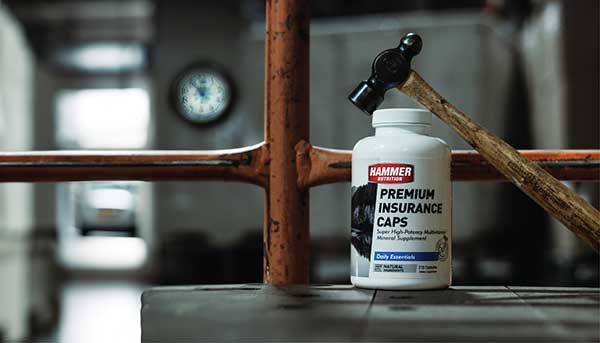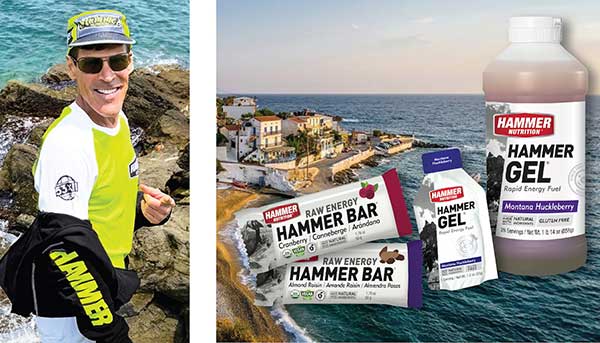
BY STEVE BORN
I'll preface this by saying that in nearly 40 years in the health food/sports supplement & fuel industry, including almost 24 years employed at Hammer Nutrition, I honestly don't think there's a sports nutrition company that spends anywhere near as much time and energy promoting overall health as they do their products (and the constant push to sell those products).
A longtime friend of Hammer Nutrition once wrote, "An endurance athlete is a healthy person first, an athlete second, and an endurance athlete third." I think that's spot on regarding why we place so much emphasis on overall health. That's why you've seen more and more articles about healthy eating practices, what to avoid (e.g., artificial ingredients, excess sodium, processed seed oils), and more. You must be healthy to accrue any benefits in your workouts and succeed in your competitions.
And, over the 36+ years of Hammer Nutrition's existence, we've talked LOTS about the harmful effects of sugar on your health and athletic performance. These days, however, as there seems to be a revival in the odd and almost universally failed practice of trying to consume as many carbohydrates as possible (using fructose as part of the formula), it’s time for a discussion on what we feel is the worst thing you can put in your body in terms of health and athletic performance—fructose.
When one looks at even a fraction of the superabundant research on fructose and its adverse effects on human health, there should be no doubt that this is a substance you want to avoid at all costs. The beginning of just one research paper lays it out quite clearly,
"The increased consumption of fructose in the average diet through sweeteners such as high-fructose corn syrup (HFCS) and sucrose has resulted in adverse outcomes in society, producing considerable economic and medical burden on our healthcare system. Ingestion of fructose chronically has contributed to multiple health consequences, such as insulin resistance, obesity, liver disorders, and diabetes [1]."
Another negative health issue associated with fructose intake is uric acid (UA) production, with elevated amounts leading to gout, which Dr. Bayne French appropriately states, "is a truly painful condition." However, elevated uric acid levels are not just associated with gout. In his article, Uric Acid and its Metabolic Effects, Dr. French writes that elevated UA "drives the formation of insulin resistance, elevated blood sugar, type 2 diabetes, heightened blood pressure, distorted cholesterol, systemic inflammation, and weight gain. It is directly implicated in a large percentage of all-cause mortality, especially from cardiovascular disease."
According to Dr. French, the bottom line is that "on its own, elevated uric acid corresponds with disease."
While uric acid is also produced from alcohol and purines, it's not much of a stretch to suggest that the primary "source material" is fructose. One reason is that fructose intake has been on the rise for decades. One piece of research showed that fructose intake per person increased by approximately 32% from the 1970s to the early 2000s. [2]. Given the increasingly ubiquitous nature of fructose, as well as predicted dietary habits (i.e., higher fructose consumption), it’s a given that fructose intake must have increased above 32% in the past 15-20 years.
The other reason fructose is most likely the overwhelmingly leading candidate for uric acid production comes from another study where fructose consumption by 21,483 people, ages ranging from 2 to 71+, was analyzed. The results shows that the mean fructose consumption was estimated to be an astounding 54.7g/day (range 38.4g/day – 72.8g/day), accounting for an eye-opening 10.2% of total caloric intake. Consumption was highest among adolescents (12–18 years) at a whopping 72.8 g/day (12.1% of total calories); One-fourth of adolescents consumed at least 15% of calories from fructose [3]. Given that many of the study subjects were younger and probably not drinking much, if any, alcohol or consuming purine-rich foods, it would seem obvious that the likely candidate for uric acid production is fructose.
One vital thing to note, made very clear in Dr. French's article, is that elevated uric acid and gout are associated with sugar-sweetened beverages but not whole fruit consumption. Research has also shown this to be true regarding, for example, coronary heart disease (CHD). A study published in The American Journal of Clinical Nutrition [4] concluded: “Intakes of TGE (glucose monosaccharides, disaccharides, and starch), total sugar, added sugar, and fructose from added sugar and juice were associated with higher CHD risk, but TFE (fructose monosaccharides and sucrose) and fructose from fruits and vegetables were not.”
Lead researcher Dr. Kristine K. Dennis summarized, “For prevention of CHD, diets emphasizing whole fruits and vegetables while limiting added sugars and refined starches should be encouraged. Our research aligns with other evidence that whole fruit appears to have a protective role, regardless of fructose content. At the same time, it also aligns with other evidence suggesting that carbohydrate quality is important for cardiovascular disease risk."
Fructose in energy fuels? Why? Why?
Everything written up to now is a “drop in the ocean" regarding the information and research that shows the negative health issues associated with fructose intake from sources aside from whole fruits and vegetables. The bottom line is that we all know, or should know, that fructose is just flat-out bad for health. So why are companies still using this unhealthy substance in their energy fuels marketed to athletes? If fructose is so bad for your general health, how can it improve your athletic performance? I believe that fructose maintaining its position as an integral part of some company’s energy fuels goes hand in hand with the "rebirth" of the concept of taking in more and more and more calories during exercise via carbohydrates. In my opinion, the people/coaching organizations/companies promoting this must be looking back several years to studies done using various carbohydrate sources solo or in combination. The big thing now, as it was quite a few years ago, is the idea that combining different types of carbohydrates allows for greater amounts of calories to be available for energy production.
The "superiority of multiple carbohydrates" argument is based on glucose (maltodextrin as well) being absorbed by one transporter (SGLT1) and fructose by another transporter (GLUT-5). My issue with that is osmolality (never mentioned in any of the studies). When you combine simple sugars and complex carbohydrates, as some of these other companies' fuels do, the mixture's concentration and osmolality change dramatically to the point where neither carbohydrate source is digested efficiently. If this is the case, why would using two different transporters matter?
The other thing that no one seems to look at in these studies is the pace/intensity of the participants. Here is but one example:
G. A. Wallis, D.S. Rowlands, C. Shaw, R. L. Jentjens, A. E. Jeukendrup, Oxidation of combined ingestion of maltodextrins and fructose during exercise. Medicine and Science in Sports and Exercise 37 (3), 426-32 (March 2005).
In this study, eight trained cyclists performed three bouts of exercise, each lasting 2.5 hours, all at an intensity of 55% maximum power output. The cyclists consumed a maltodextrin-only drink (1.8 grams per minute), a maltodextrin/fructose drink (1.2 grams of maltodextrin + 0.6 grams of fructose per minute), or water. The results showed that carbohydrate oxidation (energy output) was most significant with the maltodextrin/fructose combination, peaking at 1.5 grams/minute (360 calories/hour).
COMMENT: What stands out is the low intensity of exercise: 55% of maximum power output is a recovery pace at best. Does it matter if oxidation rates were higher using a maltodextrin/fructose combination? When exercising at an intensity that low, it's not all that difficult to believe that the athletes could consume a massive 432 calories an hour—whether from maltodextrin only or a combination of maltodextrin and fructose—and not suffer stomach issues.
The real question is, “What would happen if the intensity of exercise increased to even a moderate rate/pace?” According to exercise physiologist Dr. Carl Foster, "The frequency of abdominal complaints and symptoms during high-intensity or competitive exercise (Brouns et al., 1987) suggests that attempting to feed while the gastric emptying rate is suppressed by high-intensity exercise may be inherently futile.” In other words, the gut works hard enough to process calories during exercise. Trying to jam down more calories—in the hopes of replacing what you're burning in equal or near-equal amounts—places a tremendous burden on the gut, which will always result in unpleasant, performance-inhibiting-to-ruining issues.
Conclusions
Fructose consumption and its adverse effects on human health—including the severe issues of excess uric acid production—are well documented in abundant scientific research. Aside from consuming whole fruits and vegetables, fructose is a substance to avoid. I'm in total agreement with the sound advice of Dr. French, "Eat sugar on rare occasions, in small amounts, and with mindfulness. Next, never drink sugar or fructose." You should be as well.
You will also want to avoid fructose when fueling your body during exercise. While some companies rely on the multi-carb studies to defend their inclusion of fructose in their fuels, the fact is that unless you plan to casually jog-walk your next marathon or soft-pedal/coast your next century ride, you can expect to experience any number of stomach distress issues when using fructose in the fuel you’re consuming.
Additionally, while some companies tout fructose as a "slow-burning" carbohydrate, courtesy of its low Glycemic Index (GI) of approximately 19 to 25, GI that low makes fructose more of a “no-burning” carbohydrate. More importantly, in the words of Dr. Robert Lustig, “Yes, fructose has a low glycaemic index of 19 because it doesn't increase blood glucose. It's fructose, for goodness sake. It increases blood fructose, which is way worse. Fructose causes seven times as much cell damage as glucose because it binds to cellular proteins seven times faster and releases 100 times the number of oxygen radicals (such as hydrogen peroxide, which kills everything in sight).”
Given all the negatives associated with fructose—all short-chain carbohydrates (“simple sugars”), actually—it’s no surprise that we remain convinced that the ideal carbohydrate source for athletes engaged in moderate-to-high intensity training and racing is complex carbohydrates (maltodextrin) only. It's why we formulate Hammer Nutrition fuels the way we do. For more than 36 years, tens of thousands of athletes have enjoyed better workouts and race results—without uncomfortable GI distress—using Hammer Nutrition fuels and adopting our protocols. Put our fuels to the test against anything else out there, and we guarantee that you will, too.
REFERENCES:
[1] https://www.ncbi.nlm.nih.gov/pmc/articles/PMC6549781/
[2] https://www.sciencedirect.com/science/article/pii/S0022316622065695
[3] https://www.ncbi.nlm.nih.gov/pmc/articles/PMC2525476/
[4] https://www.sciencedirect.com/science/article/abs/pii/S0002916523661179









12 comments
Thanks to the commenter above who asked about sorbitol. I had payed attention to the electrolyte content and not the other ingredients. Now I realize a primary reason why I get diarrhea while bikepacking. I cannot digest any amount of sorbitol. While I love other Hammer products, Fizz, you and I will have an amicable divorce. I also have a tendency for low sodium so have been gravitating towards brands with a higher sodium content.
———
Hammer Nutrition replied:
Hello Linda, Thank you for your comment, I’ll clarify as I did with the other commenter. Sorbitol is not tolerated by a tiny fraction of the population and is in fact used at higher doses as a baby laxative. FIZZ is the only product we make with a little bit of this in it. We also offer our full spectrum, proportionately balanced electrolyte formula in original low sodium capsules and high sodium capsules and water soluble powder. The higher your sodium intake in your diet, the higher your sodium replacement needs will be while exercising and the converse it also true, low sodium diet = low sodium replacement when exercising. BDF
I really appreciate this information about fructose. I try very hard not to take in much sugar in its various forms except for fruit. I am curious what your understanding of aspartame is and its impact on health and athletic performance because I do drink diet soda. Has Hammer published about this in the past?
I use your fuels and do well with them!
———
Hammer Nutrition replied:
At this link on the Hammer Nutrition website – https://hammernutrition.com/pages/nutrition-questions#do-you-use-any-artificial-sweeteners-in-your-products – we write this about aspartame:
… arguably the worst of them all is aspartame—80% of all complaints to the FDA are aspartame related! Aspartame breaks down to phenylalanine and aspartic acid in our hot bodies when heated. The methanol in aspartame converts into formaldehyde in our bodies. Formaldehyde is a poison known to damage the immune and nervous system as well as cause genetic damage. Aspartame breaks down the protective coating surrounding neurons in our brain; this causes a break in the blood-brain barrier which allows toxins to move directly into the bloodstream.
Dr. Bill Misner states: "A careful review of the DVD, “Sweet Misery” (https://topdocumentaryfilms.com/sweet-misery-a-poisoned-world/) presents evidence that demands reconsideration of the harm aspartame generates by chronic use or acute dose. I once argued that some subjects could metabolize aspartame without health issues. If you evaluate the information in this DVD, you will not consume aspartame or synthetic sweeteners again."
For more information, please see the article “Aspartame: Decades of science point to serious health risks” at https://usrtk.org/sweeteners/aspartame_health_risks/
———
Hammer Nutrition replied:
Hello Brenda, thank you for your comment, good job on the efforts to minimize your intake. Beverages and packaged foods are usually the most common source of fructose in one’s diet. We’ve written extensively on the toxicity of apartame and as another commenter noted, it accounts for somewhere between 2/3 and 3/4 of adverse reaction reports the FDA receives – oh, and it’s physically addicting. It’s at the very top of my “never voluntarily consume list”, also with sucralose and acesulfame k. BDF
Can you please clarify how “maximum power output” was defined in the 2005 study? G. A. Wallis, D.S. Rowlands, C. Shaw, R. L. Jentjens, A. E. Jeukendrup, Oxidation of combined ingestion of maltodextrins and fructose during exercise. Medicine and Science in Sports and Exercise 37 (3), 426-32 (March 2005). for example, 55% of my 1-second max power would not be recovery pace, for me.
———
Hammer Nutrition replied:
Here is the information from the study. 1-second max power was not used in defining “maximum power output”…
Eight trained cyclists VO2max: 64.1 /- 3.1 mL.kg.min) performed three exercise trials in a random order. Each trial consisted of 150 min cycling at 55% maximum power output (64.2/-3.5% VO2max)
Can you please clarify how “maximum power output” was defined in the 2005 study? G. A. Wallis, D.S. Rowlands, C. Shaw, R. L. Jentjens, A. E. Jeukendrup, Oxidation of combined ingestion of maltodextrins and fructose during exercise. Medicine and Science in Sports and Exercise 37 (3), 426-32 (March 2005). for example, 55% of my 1-second max power would not be recovery pace, for me.
———
Hammer Nutrition replied:
Hello Tom, thank you for your question, but this is one for the study authors, not us, as they do not state it numerically. Certainly it ’s not from a one second effort and most likely or should be from a max sustainable power output over the duration of the effort – that’s how we race. From what we can tell, the participants are operating at a very low level of intensity, something like a walking pace. BDF
Hello,
Can you please explain why Hammer Nutrition adds sorbitol to the Fizz Endurolyte tablets?
Thank you!
———
Hammer Nutrition replied:
On average, each Endurolytes FIZZ tablet contains approximately 500 mg of the polyol (sugar alcohol) known as sorbitol. Sorbitol is not an artificial sweetener; it is naturally produced in the human body and is found in a variety of foods. The reasons why we use sorbitol in Endurolytes FIZZ are:
* It’s an undeniably better choice than an artificial sweetener like Acesulfame K or Aspartame. * Unlike xylitol, another natural sweetener, which we use in HEED and Recoverite, sorbitol exhibits excellent tablet binding properties without impeding the effervescent reaction process.
For more information and research references, please see the FAQ “Why do you use sorbitol in Endurolytes Fizz?” on the Endurolytes Fizz website page at https://hammernutrition.com/collections/fuels/products/endurolytes-fizz
———
Hammer Nutrition replied:
They will not dissolve without it and we make several other forms of electrolytes that do not contain any. BDF